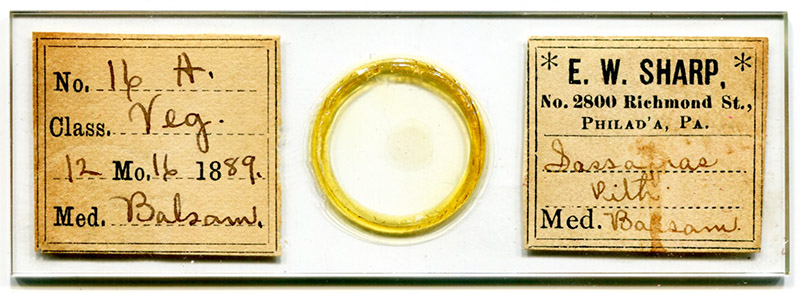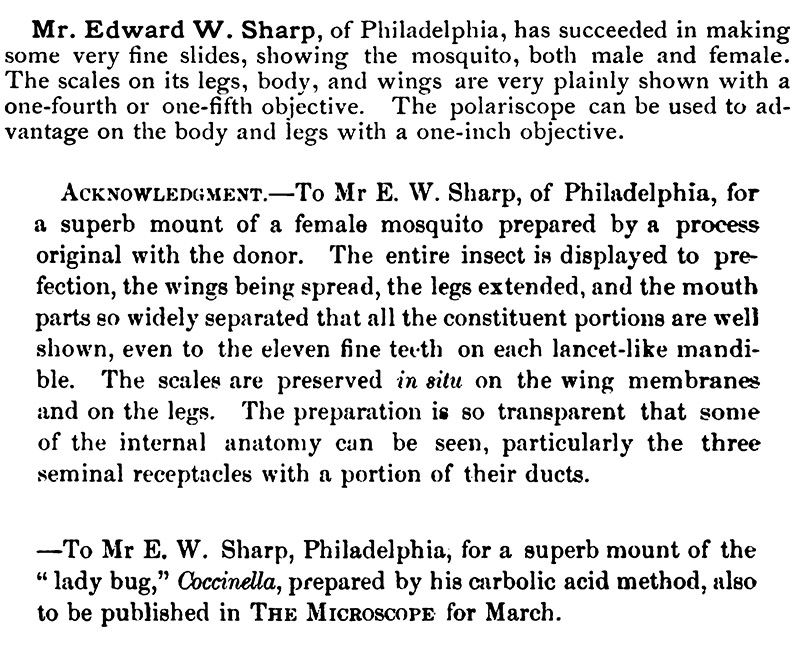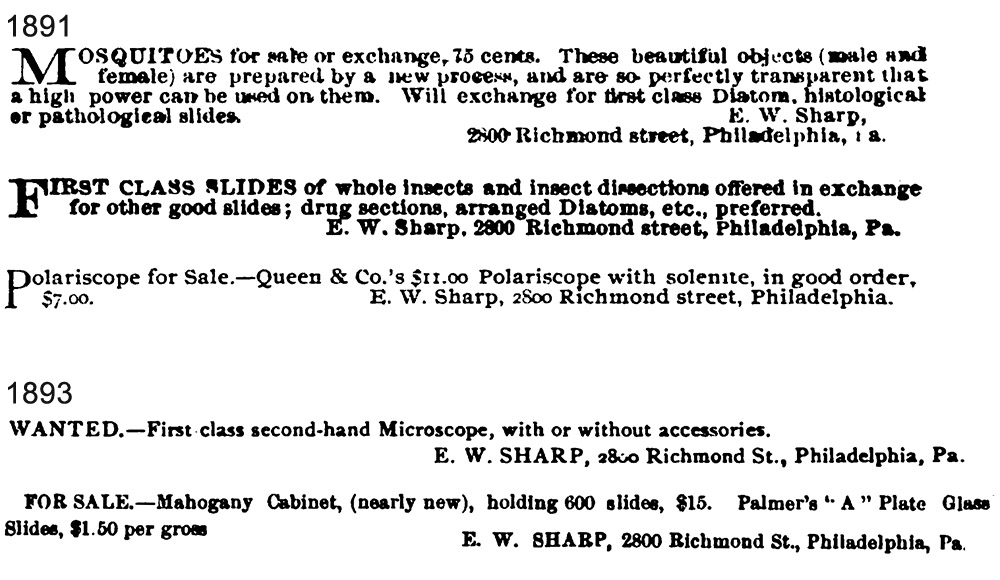Edward Wolf Sharp, 1863 - 1917
by Brian Stevenson
last updated November, 2019
E.W. Sharp was a professional American maker of microscope slides. A pharmacist by trade, Sharp probably learned microscopy during his training, since microscopic analysis of drugs and medicinal plants was usually an important aspect of a pharmacist’s education. Sharp sold his slides by mail, and presumably also from his shop in Philadelphia, between ca. 1889 and the mid-1890s. By 1900, he was no longer in either the pharmacy or microscopy business.

Figure 1.
Microscope slides by Edward W. Sharp. The upper slide is dated December 16, 1889. Sassafras roots were used in medicines, so this may have been part of a series of medicinal plant slides. Sharp was reported to have produced excellent slides of insects.

Figure 2.
Pith of a sassafras tree, by E.W. Sharp (see Figure 1). Photographed with a C-mounted digital SLR camera, a 10x objective lens, crossed polarizing filters, and a blue/green selenite.
Edward Sharp was born in 1863 in Camden, New Jersey, across the river from Philadelphia, Pennsylvania. He trained as a pharmacist, earning his Graduate in Pharmacy (Ph.G.) degree in 1884. His graduate thesis was on “electricity”. Sharp married Emma Hewitt on January 25, 1884, in her hometown of Cape May, New Jersey. They had four children, although only two survived to adulthood.
The 1885 edition of the Philadelphia City Directory (published in late 1884) shows that Edward W. Sharp was then employed as a “clerk”. The 1886 and 1887 Directories described him as a “druggist”, with shops at 2542 and 2802 Richmond Street, and home at 2802 Richmond. The 1888 Directory shows consolidation to a single shop, at 2802 Richmond, the address that is also listed in the 1889 edition. The microscope slide by Sharp that is illustrated in Figures 1 and 2, above, is dated December, 1889, and bears the address 2800 Richmond Street, indicating a move (or number reallocation) during 1889. All further records of Sharp’s pharmacy and home show him at 2800 Richmond.
Professional slide-makers frequently promoted their businesses by sending free samples to the editors of popular scientific magazines. In 1890, editors of both The Microscope and The American Monthly Microscopical Journal received slides of mosquitoes from Sharp (Figure 3). Sharp advertised these slides for sale, of male and female mosquitoes, for 75¢ each (Figure 4).
In 1891, Sharp published some of his methods for slide making in The Microscope, on the use of carbolic acid for dehydrating insect specimens, mounting with Canada balsam, and finishing with ringing cement.
Also in 1891, Sharp sought to sell his polariscope (Figure 3). His description of the instrument as a “polariscope”, rather than a microscope with polarizing apparatus, suggests that it was a dedicated instrument. It may have been an item from his schooling, as polariscopic examination of drugs and botanicals can be key to identification.
I have not found records of Edward Sharp being involved with any microscopy organizations. He did contribute outreach to local youth: in 1892, the Philadelphia YMCA reported that “a microscopy class has been formed under direction of Dr. E.W. Sharp”.
Sharp published requests in The American Monthly Microscopical Journal in January of 1893, asking for a “first-class second-hand microscope” (Figure 4). This suggests that his interest in microscopy was increasing. Paradoxically, he offered to sell a large number of unused microscope slides in November of the same year, along with a 600-slide microscope cabinet (Figure 4). Had he decided to cease large-scale commercial slide-making? I have not located any further microscope-related news of Edward Sharp after his slide and cabinet sale offers.
The Sharp pharmacy was involved in a notorious tragedy in 1895, which may have played a role in Edward leaving the pharmaceutical business:
“A mistake made by Drug Clerk Edward Parmer in E.W. Sharp's pharmacy … resulted in the death on February 16 of seven-months' old Clara Tobianco of 808 South Eighth street. The child was taken ill with bronchitis on the preceding evening and Dr. F.H. Getchell of 1432 Spruce street prescribed something in the nature of a cough mixture.
The father of the child took the prescription to Sharp's store on Saturday morning and was waited on by Parmer. At the time the father called Parmer was fixing up another prescription, three-fourths of which was composed of opium. By mistake the clerk gave the latter prescription to Tobianco instead of the medicine which he ordered.
Tobianco was instructed to give his child a dose of the medicine every two hours, and at ten minutes past six, after the little patient had been given the third dose, Parmer excitedly entered the house and announced that he had given the father the wrong medicine. He then handed the father an emetic that was given the child and he told Tobianco to summon Dr. Getchell at once.
The father hurried to the physician's house ... The child died just as the latter reached the house. The little patient had been dying from the effects of the opium, and was unconscious when death ended her sufferings.
The child's parents were greatly affected over the little one's death, and but for Officer Ratto, Parmer would probably have been mobbed by the father and four of the latter's friends. The officer was standing near the drug store about 8 o'clock when he saw the men going toward the store and ran ahead of them and got Parmer into a place of safety.
After the men had been somewhat pacified they decided that it was best to let the law take its course and made no effort to attack the clerk, who was afterward taken to the station house. Parmer was greatly grieved over the fatal blunder he had made and sympathized with the child's parents
...
When, however, the post-mortem examination was made it was found that the child had died from congestion of the lungs. and not from the effects of the narcotic, and Parmer was exonerated from blame by the coroner's jury. That Parmer should have made the mistake is considered surprising, in view of the fact that he is not a novice, but is experienced in compounding prescriptions”.
Edward Sharp remained in the pharmaceutical business until at least 1897. That year, he served as preceptor for a student in the Philadelphia College of Pharmacy. He also expanded his business in another direction: “Mr. Sharp has erected a bicycle shop in the rear of his store and it is said he is doing a large business”.
A 1900 directory of Philadelphia stated that the pharmacy at 2800 Richmond Street was then occupied by Charles O. Pfeiffer.
The 1900 USA census records that a man who was probably our E.W. Sharp was living in a boarding house in Bergen, New Jersey, and working as a “trolley time keeper”. Wife Emma and their two children lived with her mother in Cape May. She was still there at the time of the 1910 census, while Edward was boarding in Manhattan, New York, working as a “clerk” for a “railway”.
Edward Sharp died in November, 1917. Emma remarried in 1919.

Figure 3.
In 1891 and 1892, Edward Sharp sent samples of his microscope slides to the editors of popular scientific magazines, who then published descriptions of his mounts. This was a typical method by which professional slide-makers could gain easy advertising.

Figure 4.
Exchange and sales advertisements from Edward Sharp. I have not located microscopy advertisements from Sharp after his November and December offers to sell large numbers of unused slides and his mahogany cabinet.
Resources
American Druggist and Pharmaceutical Record (1895) A poisoning case, Vol. 26, page 121
American Druggist and Pharmaceutical Record (1897) Vol. 30, page 243
American Journal of Pharmacy (1884) “The following 150 students passed the examination, and were recommended to the Board of Trustees for the degree of Graduate in Pharmacy (Ph.G.): … Edward Wolf Sharp, New Jersey, Electricity”, Vol. 56, pages 231-234
American Journal of Pharmacy (1897) Classes of the Philadelphia College of Pharmacy, Vol. 69, page 63
The American Monthly Microscopical Journal (1891) Vol. 11, page 266
The American Monthly Microscopical Journal (1891) Advertisement from Edward Sharp, Vol. 12
The American Monthly Microscopical Journal (1893) Advertisements from Edward Sharp, Vol. 14
Merck's Market Report (1895) A Philadelphia clerk makes a mistake, Vol. 4, page 99
The Microscope (1891) Vol. 10, page 314
The Microscope (1892) Vol. 11, page 56
The Microscope (1892) Advertisements from Edward Sharp, Vol. 11
The Pharmaceutical Era (1895) Clerk charged with fatal error, Vol. 13, page 243
Philadelphia City Directories (1885 - 1900) accessed through ancestry.com
Sharp, E.W. (1890) Volumetric sugar table, The Microscopical Bulletin and Science News, Vol. 7, page 16
Sharp, E.W. (1891) Balsam mounts, The Microscope, Vol. 11, pages 26-29
Sharp, E.W. (1891) Carbolic acid for dehydrating, The Microscope, Vol. 11, page 90
US census and other records, accessed through ancestry.com
Young Men's Era (1892) Vol. 18, page 698



